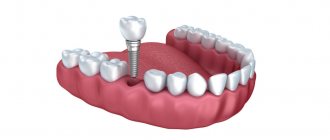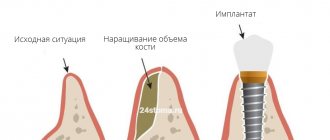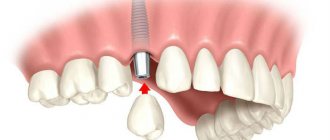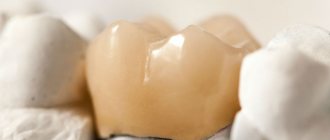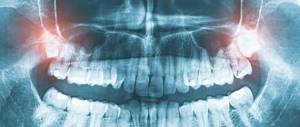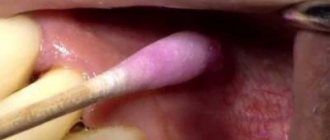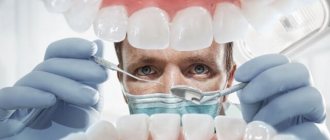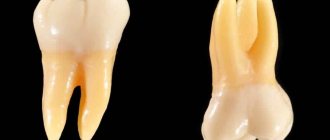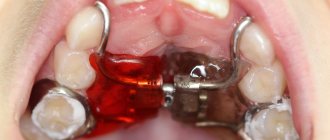Features of prosthetics for atrophy
Due to their ability to withstand heavy loads, the jaws function normally.
During chewing, blood flow and metabolic processes improve, and nutrients are supplied to the tissues in sufficient quantities. After tooth loss, pressure is redistributed, and blood circulation locally worsens. This also happens with inflammatory diseases that destroy the ligaments that support the roots. In addition, they systemically affect the periodontal tissues. The entire jaw is subject to the degenerative process. The upper alveolar process in the bottom and lateral sections of the maxillary sinuses suffers the most due to resorption (resorption). It exudes in height, which makes classical implantation impossible. This forces implant surgeons to look for alternative solutions or perform additional surgery to form a bed for the pin.
Implantation in our center consists of 6 steps:
- sanitization of the oral cavity;
- 3D process modeling;
- surgical procedures;
- formation of a smooth gingival cuff;
- installation of abutments for fastening crowns;
- taking impressions, making and fixing crowns and dentures.
Stages of dental implant installation
How to install implants in conditions of bone deficiency
Classic dental implantation in case of insufficient bone tissue is preceded by bone augmentation surgery or sinus lift. Before implantation, a period of engraftment of the grafting material (4-6 months) is waited. During this period, the patient is fixed with a removable prosthesis.
If I and II degrees of loss are diagnosed, implantation and replanting of cells can be organized simultaneously. It is possible to exclude bone grafting if all or almost all teeth in a row are missing - artificial roots are implanted using a one-stage protocol at an angle (into the deep bone layers).
Nesterenko Alexey Pavlovich Surgeon-implantologist, doctor of the highest category
Can implantation stop cell loss?
In addition to solving the problem of aesthetics and restoring the functionality of the dentition, installing implants helps prevent resorption. Due to the implants, the load on the jaw is distributed evenly, internal metabolic processes in the cells are activated, cellular nutrition is established - the atrophy process stops.
What does bone atrophy lead to?
The degenerative process does not go unnoticed for the gums. In addition to problems with implantation, the following are observed:
- Changes in the relief of the gums: the upper one rises, the lower one sags.
- Deterioration in appearance. Sunken lips and cheeks, drooping corners make the face asymmetrical and age.
- The teeth move towards the socket and become crooked. This is fraught with functional disorders when chewing and deterioration of the bite.
- The absence of anterior units negatively affects speech and causes discomfort when communicating.
Prices
The cost of the operation depends on the chosen technique. The most expensive will be implantation with preliminary osteoplasty: the process is labor-intensive and expensive artificial material is used.
A classic operation and a protocol with an immediate load will cost approximately the same if several elements need to be restored. When a complete or almost entire row of teeth is missing, one-stage implantation is cheaper due to fewer implants and a reduction in the number of operations.
| Service | Price |
| Sinus lifting in the area of one tooth (excluding the cost of material) | from 10,000 rub. |
| Directed regeneration in the area of 1 tooth (excluding material cost) | from 10,000 rub. |
| Installation of a classic implant ROOTT FORM (Switzerland, Trate AG) | from 27,000 rub. from 32,000 rub. promotion |
| Open sinus lift, bone grafting (for 1 zone, excluding material cost) | from 35,000 rub. |
| Osteoplasty with splitting of the alveolar ridge (for 1 zone excluding the cost of material) | from 35,000 rub. |
| Guided bone tissue regeneration (for 1 zone excluding material cost) | from 35,000 rub. |
| Installation of a one-stage implant (Switzerland, Trate AG) with an adaptation crown | from 44,000 rub. |
| Installation of a classic ROOTT implant with an adaptation crown (Switzerland, Trate AG) | from 44,000 rub. |
| Installation of a one-stage multi-unit implant with screw fixation (Switzerland, Trate AG) with an adaptation crown | from 50,000 rub. |
| Installation of a classic Nobel implant (Sweden, Nobel Biocare) | from 60,000 rub. |
| Installation of a classic Nobel implant (Sweden, Nobel Biocare) with an adaptation crown | from 85,000 rub. |
| One-stage complex implantation for completely edentulous one jaw, including an adaptive prosthesis (combination of 6-12 COMPRESSIVE, BASAL implants of the ROOTT system (Switzerland, Trate AG) on a metal frame with cement fixation. | from 265,000 rub. |
| One-stage complex implantation for completely edentulous one jaw, including an adaptive prosthesis (combination of 6-12 COMPRESSIVE, BASAL implants of the ROOTT system (Switzerland, Trate AG) on a titanium frame with cement fixation | from 295,000 rub. |
| One-stage complex implantation for completely edentulous one jaw, including an adaptive prosthesis on a titanium frame supported by 6-12 implants of the ROOTT system (Switzerland, Trate AG) multi-unit with screw fixation | from 325,000 rub. |
| One-stage complex implantation with complete edentia of both jaws, including an adaptive prosthesis (combination of 12-24 COMPRESSIVE, BASAL implants of the ROOTT system (Switzerland, Trate AG) on a metal frame with cement fixation | from 480,000 rub. |
| One-stage complex implantation with complete edentia of both jaws, including an adaptive prosthesis (combination of 12-24 COMPRESSIVE, BASAL implants of the ROOTT system (Switzerland, Trate AG) on a titanium frame with cement fixation | from 495,000 rub. |
| One-stage complex implantation for completely edentulous 1 jaw, including a ceramic-composite prosthesis, put on on days 3-4, a combination of 6-12 screw-fixed implants, ROOTT system (Switzerland, Trate AG). No re-prosthetics required | from 580,000 rub. |
| One-stage complex implantation with complete edentia of both jaws, including an adaptive prosthesis on a titanium frame supported by 12-24 implants of the ROOTT system (Switzerland, Trate AG) multi-unit with screw fixation | from 590,000 rub. |
Consultation and diagnostics are free!
All prices Promotions
Solutions without bone grafting
Since osteoplasty is a traumatic and expensive method, which also delays the prospect of prosthetics with a fixed prosthesis, the clinic offers innovative systems with instant loading protocols.
The all-on-4 technology is due to the implantation of 4 pins: 2 are installed vertically, 2 on the sides at an angle of 45º. The method allows implantation in patients with moderate jaw resorption. The primary prosthesis is inserted depending on the condition of the soft tissues - on the 1st-3rd day.
The all-on-6 protocol is identical to the previous one, only for installation 6 one-piece or two-piece pins with multi-unit abutments are taken. Two of them are fixed in front, four each in the distal section and in the place of the molars.
Zygoma zygomatic implantation is a solution for people with complete edentia. The protocol involves the installation of 6 cm screws through the jaw with fastening in the zygomatic bone, which is not susceptible to thinning. If there is no limitation, a permanent prosthesis is immediately placed.
Classic delayed load protocol
Classic surgery is performed when there is sufficient bone tissue (at least 10 mm) in two stages. The protocol involves delayed loading on the implants: they need time to fuse with the jaw.
An implant with dismountable elements (an abutment and an intraosseous part) is fixed using the method of detaching a gum flap - the gum is cut and sutured.
2-6 months after the operation, the implant is opened, a gum former is placed on it, and two weeks later - an abutment and an individual permanent prosthesis.
1
Implantation
Implantation
Installation of a butterfly prosthesis or temporary crown (if it is possible to remove the bite)
4-6 months
2
Prosthetics
Installation of abutment and permanent crown
Osteoplasty in case of a lack of tissue is organized before the implantation of titanium roots or simultaneously. The operation is justified for single defects. If the patient has multiple defects or complete edentia, classical surgery is difficult due to acute bone loss and the need to build up a large volume of bone.
If there is not enough bone tissue for implantation, classical implants in some clinics are implanted without tissue augmentation. The doctor suggests:
- install titanium roots only in the frontal zone (signs of atrophy rarely appear here);
- fix the implant in the area of the posterior wall of the maxillary sinus at the end of the dentition, behind the maxillary sinus (the height of the bone here reaches 20 mm);
- implant short and thin implants - implantation is possible in case of atrophy of the bone tissue of the lower jaw, without touching the jaw nerve.
But the described methods are unreliable: the risk of weak primary stability of the implant and its loosening cannot be excluded.
When performing an operation, it is important to use implants from the same manufacturer (with the same impurities - metals in a titanium alloy). When fixing implants, impurity metals of different brands in the acidic environment of the oral cavity may not combine and cause allergies, galvanic syndrome, and rejection of titanium roots. The ROOTT implant system is unique: a range of implants from one manufacturer is used in all clinical cases.
Cost of implantation for bone tissue atrophy
The cost of full prosthetics on implants for edentulous patients using the All-on-4 and All-on-6 systems.
Prices are valid for April 2021
| System name | Cost, BYN |
| All-on-4 Osstem (South Korea) - the entire jaw on 4 implants with work and prosthesis | from 6 500 |
| All-on-4 AlphaBio, MIS (Israel) - entire jaw on 4 implants with work and prosthesis | from 5 980 |
| All-on-4 Straumann (Switzerland) - entire jaw on 4 implants with work and prosthesis | from 9 600 |
| All-on-6 Osstem (South Korea) - the entire jaw on 6 implants with work and prosthesis | from 9 000 |
| All-on-6 AlphaBio, MIS (Israel) - entire jaw on 4 implants with work and prosthesis | from 5 980 |
| All-on-6 Straumann (Switzerland) - the entire jaw on 6 implants with work and prosthesis | from 11 000 |
Prices for basal implantation surgeries are 30-40% lower due to a reduction in the amount of work and savings on materials, but the specialists of the Dudko and Sons clinic do not perform or recommend this type of treatment.
Basal implantation
The process of dental implantation is often complicated by complete or partial edentia. This problem is solved by basal implantation technology, with the help of which implants are installed in the hard parts of the jaw bone, i.e., in the basal layer and cortical plate. The technological feature of basal implantation is that the installation of implants is carried out with an immediate load. This makes it possible to implant teeth even with severe atrophy of bone tissue.
Another name for the method is “implantation with instantaneous load”, or “single-stage implantation”. The patient does not have to wait until the implants are fully implanted to be able to chew - the immediate load stimulates blood circulation in the bone cells and accelerates the natural regeneration process. Osseointegration occurs simultaneously with the use of implants.
Indications and contraindications for basal implantation
Indications for basal implantation are any problems with bone tissue, as well as the need for urgent restoration of the dentition. In addition, implantation with immediate loading is used in the following cases:
- implantation of one tooth;
- partial or complete absence of teeth;
- gum diseases such as periodontitis and periodontal disease;
- reduction in the volume of bone tissue and the inability to build it up.
As for contraindications, these include serious general diseases, such as diabetes mellitus, malignant tumors, HIV, tuberculosis, etc. The presence of such diseases can lead to serious problems and implant rejection. Other contraindications to immediate loading implantation are:
- insufficient width of the alveolar ridge (less than 5 mm);
- diseases of the oral cavity - pulpitis, stomatitis, tartar, cyst or granuloma;
- pregnancy and lactation.
One more point should be noted: basal implantation is still recommended in the absence of at least three teeth. Of course, it can also be used to restore one tooth, but in this case the requirements for bone tissue are much higher and gum grafting is likely to hide the subsidence.
Dental implantation for bone tissue atrophy
To understand the advantages of basal implantation technology, you need to understand what happens to bone tissue when teeth are removed. Bone tissue consists of a central cancellous bone, a deep basal region, and a shell called the cortical plate. When the root of a tooth is removed, the functioning of the capillaries is disrupted, and the spongy tissue is no longer saturated with oxygen, which leads to its atrophy. As a result, it shrinks, the gum sags, and the alveolar ridge becomes narrow - this creates big problems during implantation.
Basal implantation allows implants to be installed in the basal and cortical layers, which do not undergo atrophy. This is the only method by which implants can be placed without increasing bone volume. The peculiarity of basal implants is that they interact with all three sections of bone tissue. Their design resembles the letter “T”, which is installed on the side of the jaw, forming a dense cortical layer around the implant, which perfectly stabilizes the structure.
Advantages of the immediate load implantation method
Implantation with immediate load has a lot of competitive advantages over other methods of dental implantation:
- Speed of treatment and recovery. Prostheses can be installed almost immediately after the installation of implants, since the immediate load is transferred to them, and they put pressure on the bone, saturating it with oxygen, which promotes rapid healing.
- Simultaneous implantation is suitable for those patients who were previously recommended a sinus lift.
- Short recovery period, no stitches. To install implants during immediate implantation, a small puncture is sufficient; there is no need to cut the gum, so there is no bleeding or discomfort.
- For 90% of cases of basal implantation, bone tissue augmentation is not required - implants can be installed using the existing volume.
- When bone tissue is quickly restored, this has a beneficial effect on the functioning of the facial muscles and the appearance of the patient.
- This is the only method of implantation immediately after eliminating periodontitis.
- Basal implantation significantly reduces the risk of inflammation, so the risk of implant rejection is considered minimal.
- The use of fewer materials than with classical dental implantation makes basal implantation significantly more economical.
Technology and stages of one-stage implantation
In implantation with immediate loading, depending on the technology used, different treatment protocols can be used. Thus, for patients with severely atrophied bone tissue, the Basal Complex technology is used.
If the atrophy is not severe, but there are cysts on the roots of the teeth or periodontitis, then All-On-6 technology is used.
When the bone tissue is of sufficiently good quality and there are no other contraindications, doctors use All-On-4 technology for basal implantation.
InstanTeeth technology is suitable for the restoration of individual teeth and segmental restorations, even with signs of bone tissue atrophy.
Implantation with instant loading allows you to restore teeth within a week. The recovery steps are as follows:
Diagnostics
The duration of this stage does not exceed 1–2 days. The dentist completely examines the patient’s bone tissue and oral cavity. It is also necessary to take a blood test and provide detailed information about existing common diseases.
Modeling
After studying the bone tissue, the doctor selects implants, selects their shape and size, the angle of fixation and creates a three-dimensional model of the future jaw.
Installation of implants
No incisions are made, no stitches are placed, implantation is performed by puncture, which is very helpful for patients with atrophy.
Prosthetics
Thanks to the successful implantation technology with instant loading, dentures can be attached 2-3 days after installation of the implants; no healing time is required. For the manufacture of prostheses, metal-plastic is used, which is lighter than metal-ceramics and allows for on-site adjustments. This is very convenient when it takes a long time to adjust the prosthesis after missing teeth.
Permanent prosthetics
Installation of permanent prostheses made of metal-ceramics is carried out no earlier than a year after implantation - during this time the implants completely take root.
In general, with implantation with immediate loading, permanent prostheses can be installed immediately after implantation, but in the presence of bone tissue atrophy, it is recommended to start with temporary prostheses.
Implant lifespan
One of the significant advantages of instantaneously loaded implants is that titanium basal implants have a lifelong service life. Implantation takes place in the least traumatic way, since implants are biocompatible with the human body. As for implanted prostheses, they have to be changed throughout life, although zirconium dioxide prostheses can last 20–25 years without replacement.
The rules for caring for dentures during implantation are quite simple and do not differ much from the rules for caring for your own teeth: brush regularly, visit the dentist to monitor their condition and generally monitor your health.
Basal implantation is a new step in dental prosthetics technology. Reviews from patients who have already undergone treatment indicate the comfort of the procedure and reliable results of prosthetics. Basal implantation can solve many problems!
You can make an appointment with an implantologist at The doctor will be happy to see you, conduct a high-quality consultative examination and select the appropriate option for restoring the lost tooth.
Mira Dentistry. Detailed information and registration by phone: +7 (391) 200-1000.
Make an appointment
Request a call
Recovery period
Engraftment of a bone graft and restoration of tissue volume are complex processes. In order for them to proceed without complications, it is important to exclude the impact of negative factors on the body. In the first weeks after bone grafting in preparation for implantation, the following is prohibited:
- fly on a plane,
- dive and swim,
- eat hard, too cold and hot food,
- visit the bathhouse and sauna.
To eliminate the possibility of complications, the patient must follow all the specialist’s recommendations and undergo regular examinations.
Indications and contraindications for bone grafting
MedGarant employs specialists who have undergone training and practice in clinics in Germany, Israel, and Sweden. They say with confidence: every 2-3 patients need bone grafting surgery before implantation.
Bone tissue decreases if a tooth is missing for a long time, as well as after traumatic removal, infection, such as a cyst.
An implant can be placed in an area of bone atrophy only after surgery to reconstruct it. The need for it is determined by the doctor after a computed tomography scan. A three-dimensional image of the jaw allows you to accurately plan the location of the implant and determine the minimum extent of the operation.

